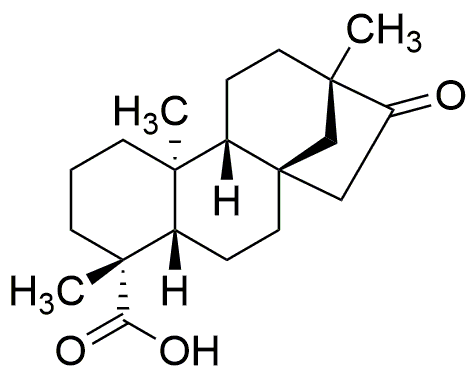Isosteviol is widely utilized in research focused on:
- Food Industry: Used as a natural sweetener, it offers a low-calorie alternative to sugar, making it ideal for products aimed at health-conscious consumers.
- Pharmaceuticals: Its anti-inflammatory and antioxidant properties make it a candidate for developing medications that target chronic diseases, providing potential health benefits without significant side effects.
- Cosmetics: Incorporated into skincare products for its moisturizing and soothing effects, it helps improve skin health and appearance, appealing to consumers seeking natural ingredients.
- Agriculture: Used as a plant growth regulator, it enhances crop yield and quality, supporting sustainable farming practices and meeting the demands of the agricultural sector.
- Biotechnology: In research settings, it serves as a model compound for studying metabolic pathways, aiding scientists in understanding complex biological processes.
General Information
Properties
Safety and Regulations
Applications
Isosteviol is widely utilized in research focused on:
- Food Industry: Used as a natural sweetener, it offers a low-calorie alternative to sugar, making it ideal for products aimed at health-conscious consumers.
- Pharmaceuticals: Its anti-inflammatory and antioxidant properties make it a candidate for developing medications that target chronic diseases, providing potential health benefits without significant side effects.
- Cosmetics: Incorporated into skincare products for its moisturizing and soothing effects, it helps improve skin health and appearance, appealing to consumers seeking natural ingredients.
- Agriculture: Used as a plant growth regulator, it enhances crop yield and quality, supporting sustainable farming practices and meeting the demands of the agricultural sector.
- Biotechnology: In research settings, it serves as a model compound for studying metabolic pathways, aiding scientists in understanding complex biological processes.
Documents
Safety Data Sheets (SDS)
The SDS provides comprehensive safety information on handling, storage, and disposal of the product.
Product Specification (PS)
The PS provides a comprehensive breakdown of the product’s properties, including chemical composition, physical state, purity, and storage requirements. It also details acceptable quality ranges and the product's intended applications.
Certificates of Analysis (COA)
Search for Certificates of Analysis (COA) by entering the products Lot Number. Lot and Batch Numbers can be found on a product’s label following the words ‘Lot’ or ‘Batch’.
Numéro de catalogue
Numéro de lot/série
Certificates Of Origin (COO)
This COO confirms the country where the product was manufactured, and also details the materials and components used in it and whether it is derived from natural, synthetic, or other specific sources. This certificate may be required for customs, trade, and regulatory compliance.
Numéro de catalogue
Numéro de lot/série
Safety Data Sheets (SDS)
The SDS provides comprehensive safety information on handling, storage, and disposal of the product.
DownloadProduct Specification (PS)
The PS provides a comprehensive breakdown of the product’s properties, including chemical composition, physical state, purity, and storage requirements. It also details acceptable quality ranges and the product's intended applications.
DownloadCertificates of Analysis (COA)
Search for Certificates of Analysis (COA) by entering the products Lot Number. Lot and Batch Numbers can be found on a product’s label following the words ‘Lot’ or ‘Batch’.
Numéro de catalogue
Numéro de lot/série
Certificates Of Origin (COO)
This COO confirms the country where the product was manufactured, and also details the materials and components used in it and whether it is derived from natural, synthetic, or other specific sources. This certificate may be required for customs, trade, and regulatory compliance.


